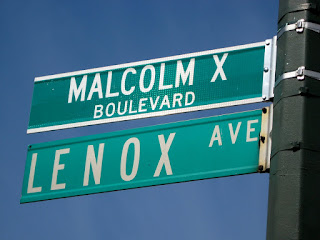 Malcolm X Boulevard, Lenox Ave. Image courtesy Public Domain Clip Art | Magazines catering to African-Americans may be falling short in their efforts to educate readers about weight loss, a new University of Iowa study suggests. African-American women's magazines are more likely to encourage fad diets and reliance on faith to lose weight, while mainstream women's magazines focus more on evidence-based diet strategies, according to the study by UI researcher Shelly Campo, published in a recent issue of the journal Health Communication. |
Campo and co-author Teresa Mastin, an associate professor in the Department of Advertising, Public Relations, and Retailing at Michigan State University, analyzed 406 fitness and nutrition articles published between 1984 and 2004 in three major African-American women's magazines -- Ebony, Essence and Jet -- and three popular mainstream women's magazines -- Good Housekeeping, Better Homes and Gardens, and Ladies' Home Journal.
The magazines suggested many of the same weight-loss strategies, but mainstream magazines were twice as likely to suggest eating more whole grains and protein, smaller portions, and low-fat foods. Relying on God or faith was suggested by 1 in 10 weight-loss stories in the African-American magazines, but in almost no weight-loss stories in the mainstream magazines.
Fad diets were promoted as legitimate strategies in 15 percent of weight-loss stories in the African-American magazines, compared to only 5 percent in the mainstream magazines. Fad diets, defined as diets that may work in the short term but often do not result in sustained changes, included the Dick Gregory Bahamian Diet, the South Beach Diet, the Hilton Head Diet, and the Atkins Diet.
Mainstream magazines offered more strategies per article than African-American magazines. And, while mainstream magazines increased fitness and nutrition coverage during the second decade as the severity of the obesity epidemic unfolded, African-American magazines did not.
"The study clearly points to a need for public-health advocates and advocates of the African-American community to push their media to increase coverage of overweight and obesity health issues," Campo said.
The research is a companion study to previous work Mastin and Campo published in the Howard Journal of Communications in Oct. 2006. The first study showed that food and nonalcoholic beverage ads outnumbered fitness and nutrition articles 16 to 1 in Ebony, Essence and Jet between 1984 and 2004. The 500 ads were primarily for foods high in calories but low in nutritional value, Campo said.
In the new paper, Campo and Mastin note that both types of magazines tend to place responsibility for weight loss on the individual, rather than examining environmental and economic factors that make weight loss difficult. More than 83 percent of strategies focused on behavior changes, while less than 7 percent focused on environment. For example, magazines recommended eating well and staying active, but rarely addressed issues like availability and cost of healthy food, recreational opportunities in communities, or existence of school- or work-based fitness programs.
"Both genres are highly guilty of over-reliance on individual strategies," Campo said. "We blame individuals too much for circumstances that are not entirely within their control. We know people living in unsafe neighborhoods are much less likely to exercise. And fast food is cheap compared to fresh fruit and vegetables. To tell a poor person that they made a bad choice because they couldn't afford the salad fixings raises some ethical concerns."
African-Americans represent at least 90 percent of the readership of Ebony, Essence and Jet, but 11 percent or less of Better Homes and Gardens, Good Housekeeping and Ladies' Home Journal. The magazines were selected for the study because of their large circulation and longevity over the 20-year period.
STORY SOURCE: University of Iowa News Services, 300 Plaza Centre One, Suite 371, Iowa City, Iowa 52242-2500
Contact: Nicole Riehl nicole-riehl@uiowa.edu 319-384-0070 University of Iowa












No comments:
Post a Comment